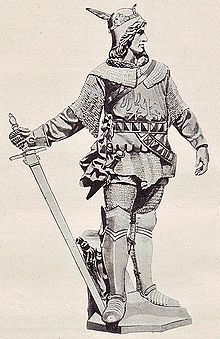Waldemar (Brandenburg)

Waldemar the Great (also Woldemar ; * around 1280 ; † August 14, 1319 in Bärwalde ) from the Ascanian dynasty was Margrave of Brandenburg as co-ruler from 1302 and sole ruler of Brandenburg from May 1309, both of the areas of the Johannine line and as guardian of the still underage Johann, son of Hermann “the Tall One” , regent of the landscapes from the Ottonian line. From 1318 to 1319 he was the guardian of his cousin Heinrich II.
Life
Waldemar's parents were Margrave Konrad I (* around 1240; † 1304) of Brandenburg ⚭ 1260 Constantia of Poland († 1281), whose father was Duke Przemysł I of Greater Poland .
In the Treaty of Soldin in 1309, Waldemar ceded his claims to the Duchy of Pomerania with Danzig in return for a payment of 10,000 Marks of silver to the Teutonic Order , but the castle districts of Stolp and Schlawe initially remained with Brandenburg. These lands were ceded to Duke Wartislaw IV of Pomerania in Wolgast in 1317 together with Rügenwalde .
In 1312 he waged war with the Margrave of Meißen , Friedrich the bitten , took him prisoner and forced him to sign the Treaty of Tangermünde on April 14, 1312 . In 1316 he occupied Dresden . In 1319 Waldemar acquired Züllichau and Schwiebus for Brandenburg by exchanging them for the Land of Crossen.
1315 occupied Waldemar in so-called Margrave War the rule Stargard , but lost to Henry II. Of Mecklenburg the Battle of Gransee and had after Templin peace from November 25, 1317, the country Stargard to Henry II. Return.
In 1309 Waldemar married Agnes von Brandenburg (~ 1298–1334), a daughter of Margrave Hermann . Through this marriage, because of the close relatives, a papal dispensation had to be obtained, he was able to implement the previously assumed guardianship of Johann , his underage brother-in-law, against which the guardian appointed by the deceased father, a selection of noblemen from the Old Marks, vehemently opposed. Thereby he united under his regiment until the age of majority (1315) of the ward, the landscapes of both Brandenburg lines (Stendaler line and Salzwedeler line, also called Johanne line & Otton line). That Johann (V) died in 1317 at the age of 15, with which the Ottonian line died out and the division of Brandenburg, which had been initiated in 1258, was practically over.
Margrave Waldemar died in 1319 without an heir of his own. His underage cousin Heinrich II of Brandenburg followed him. Serious conflicts immediately broke out over the exercise of the right of guardianship and, accordingly, the state administration. With Heinrich's very early death, just a year later, the Ascanian line as Margraves of Brandenburg died out in 1320 .
Waldemar was in almost constant financial embarrassment throughout his life. To finance his extremely splendid habitus as sovereign and his numerous campaigns, he pledged or sold landscapes or sovereign regalia repeatedly.
The wrong Waldemar
In 1348 an old man reported to the Archbishop of Magdeburg and claimed that he was the real Margrave Waldemar, who had just returned from a pilgrimage from the Holy Land . The wrong people were buried in 1319. King Charles IV then enfeoffed him with the Mark Brandenburg until he was exposed as an impostor in 1350 ; see. Wrong Woldemar .
Monuments
- 1894 Monument by Max Unger on Berlin's Mühlendammbrücke (Fischerbrücke) - according to Lehnert, prototype of the early statues in Siegesallee
- 1900 Central statue of monument group 8 in the Siegesallee by Reinhold Begas with busts (secondary figures) of Siegfried von Feuchtwangen and Heinrich Frauenlob von Meißen .
literature
-
Karl Friedrich von Klöden : Diplomatic history of the Margrave Waldemar von Brandenburg from the years 1295-1323 .
- Volume 1, Berlin 1844 ( books.google.de )
- Volume 4, Berlin 1845 ( books.google.de )
- Karl Friedrich von Klöden : Diplomatic history of the margrave Waldemar of Brandenburg, who was declared wrong . Volume 1, Berlin 1845 ( books.google.de )
- Richard George (Ed.): Hie good Brandenburg always! Historical and cultural images from the past of the Mark and from old Berlin up to the death of the Great Elector . Published by W. Pauli's Nachf., Berlin 1900.
- Uta Lehnert: The Kaiser and the Siegesallee. Réclame Royale . Dietrich Reimer Verlag, Berlin 1998, ISBN 3-496-01189-0 .
- Wilhelm von Sommerfeld: Waldemar (Margrave of Brandenburg) . In: Allgemeine Deutsche Biographie (ADB). Volume 40, Duncker & Humblot, Leipzig 1896, pp. 677-689.
Individual evidence
- ↑ a b Gerd Heinrich (Ed.): Handbook of the historical sites of Germany . Volume 10: Berlin and Brandenburg. With Neumark and Grenzmark Posen-West Prussia (= Kröner's pocket edition . Volume 311). 3rd, revised and expanded edition. Kröner, Stuttgart 1995, ISBN 3-520-31103-8 , pp. 407 and 494.
- ↑ Uta Lehnert: The Kaiser and ... , p. 390; according to Richard George (ed.): Hie gut Brandenburg… , p. 132f, the monument was erected in 1895.
| predecessor | Office | successor |
|---|---|---|
| Otto IV. |
Margrave of Brandenburg 1308–1319 |
Henry II |
| personal data | |
|---|---|
| SURNAME | Waldemar |
| ALTERNATIVE NAMES | Waldemar the Pious |
| BRIEF DESCRIPTION | Margrave of the Mark Brandenburg |
| DATE OF BIRTH | around 1280 |
| DATE OF DEATH | August 14, 1319 |
| Place of death | Bärwalde |
